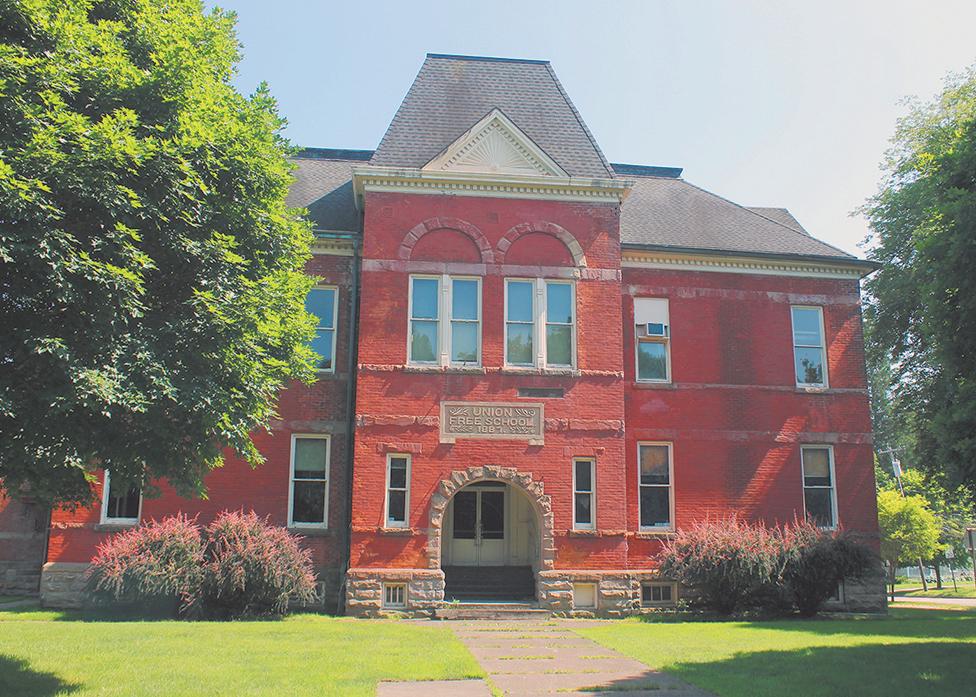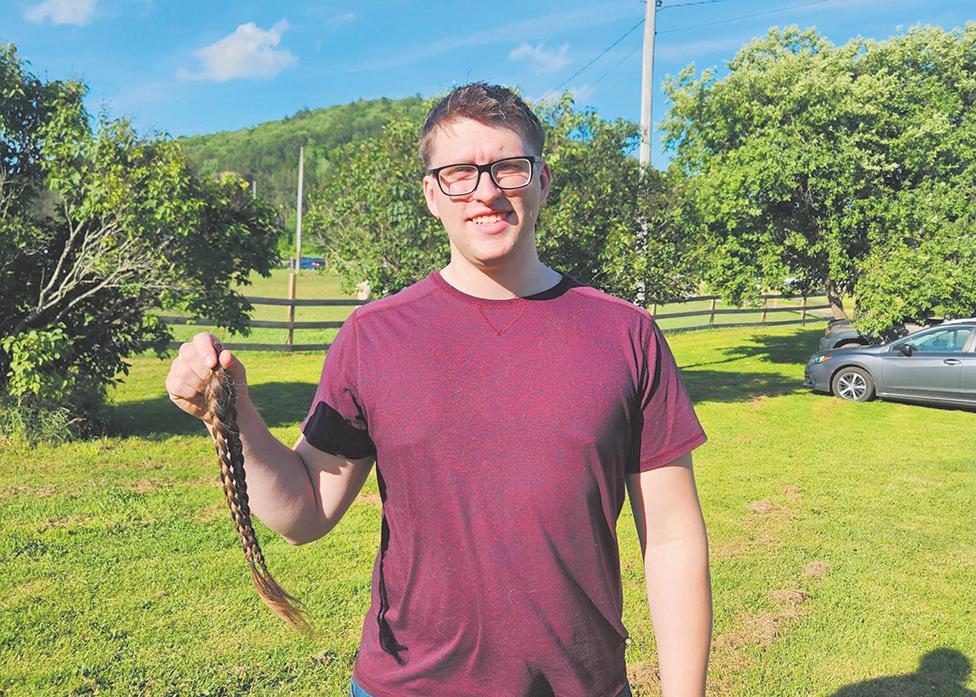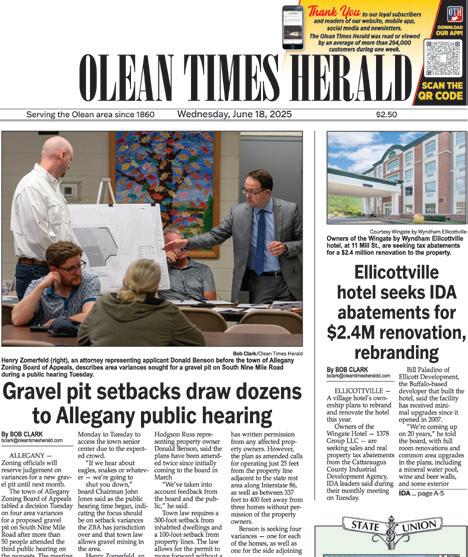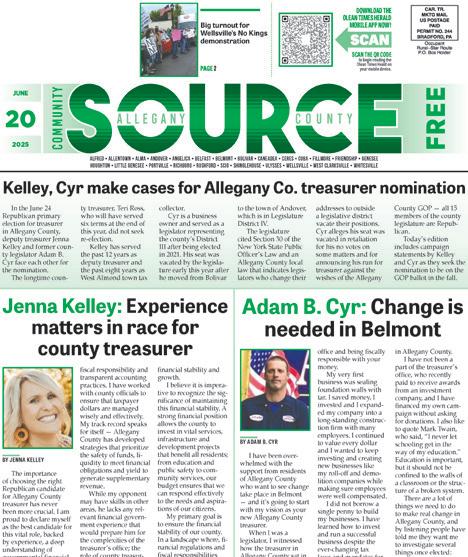




BY KELLEN M. QUIGLEY
ELLICOTTVILLE
— The village of Ellicottville has been awarded $1 million in grant funding for infrastructure projects, Gov. Kathy Hochul announced July 2.
The $1 million grant will support infrastructure improvements, such as utility upgrades, site preparation and streetscape enhancements for 1-7 Washington St. — the 1887 Building — in the heart of the village.
Mayor John Burrell said the village is very pleased with the announcement.
Each county had the opportunity to apply for the grants, he said, and when the village found out about the program, they put a presentation together for Cattaraugus County officials.
“We took a developer with us and said we think we have a shot at this,” he said. “(The village) would do the application fee and all the heavy lifting. And the county legislature supported us unanimously.”
The infrastructure upgrades are key to the village’s plan to
adaptively reuse this historically significant building from 1887 into a mixed-use development that will provide 15 workforce housing units and commercial space to support local businesses, Burrell said.
“If you had fewer than 10 proposed units, it was for $500,000, and if you have over 10, it’s $1 million,” the mayor explained. “It’s right in our square, so it’s very important.”
When the village was founded as the Cattaraugus County seat, the intersection of Jefferson and Washington streets was designed as a public square with the school on the southeast corner, the first church on the southwest corner, the county center on the northwest corner and the county jail on the northeast corner, Burrell said.
The 1887 Building was the third school building to stand on the Public Square. Constructed in 1887–88, the current building stands on the foundation stones taken from the old county jail that used to be where the current Ellicottville post office is located. Since Ellicottville was

no longer the county seat, the county jail was disassembled and the stones were carried across the street to the new building.
This project’s grant funding is part of more than $36 million awarded to 48 projects across New York state through the County Infrastructure Grant Program. First launched in November 2024 and administered by Empire State Development, the
program awards grants to support small- and medium-sized county-led infrastructure projects.
“I know firsthand how critical infrastructure is in order to uplift communities and bring families and loved ones together,” Hochul said.
“From my early days on a Town Board to serving as Erie County Clerk and in Congress, I’ve seen how investments like these can breathe new life into neighborhoods, drive
housing growth, support vibrant downtowns and bring new energy to local economies. We’re putting local priorities front and center as we build a stronger New York.”
The 1887 Building is a handsome example of Romanesque Revival architecture, the only civic structure in the village built in this style. Visitors tend to be drawn to the building because of its unique style with a rounded archway over the
There are many reasons homeowners consider adding a room to their current homes. Some outgrow an existing space, while others take up new hobbies or have different needs that were not apparent when purchasing the home. Indeed, a room addition can remedy a host of issues affecting a home. Those considering adding a room may wonder what is involved in this type of project. According to The Spruce, no home improvement project is more complicated or expensive than building an addition. The National Association of Realtors says building an addition can cost between $90,000 and $270,000, depending on the size and intended purpose of the room. An addition structurally changes a home, which requires the work of professionals whether homeowners plan to build upwards or outwards.
With so much to ponder when considering a home addition, here’s a look at what homeowners can expect of the process.
• Design and planning: Homeowners must determine the purpose behind the addition and how it will integrate with the existing home. A bedroom design likely will be different from a garage addition or family game room.
• Hire an engineer and contractor: An addition changes the footprint of a home. Homeowners will require professional contractors and structural engineers/architects
to properly design the addition and ensure that it will not compromise the existing structure. Detailed architectural plans will be drawn up considering the layout, size and integration with the existing structure. The home may require a new property survey as well.
• Comply with building codes: The project will have to meet with local zoning regulations, building codes and homeowners association rules.
• Timing involved: Adding a room is a major overhaul of a space. It may require months of a home being in upheaval. If the renovations are particularly extensive, homeowners may need to temporarily move out of the space. Electrical, plumbing and HVAC must be considered, and drywall and finishing the interior are some of the last steps to make the room habitable.
• Demolition: Adding a room may involve
taking down walls or modifying existing spaces, necessitating hiring a dumpster to remove debris. This is an added consideration and expense.



Putting an addition on a home is a complex process that will take time and money. Such a project requires careful planning and consultation with an array of experts.



recessed front entrance and the heavy stone detailing around the windows and doorways. Notable features include the rounded archway over the recessed front entrance and the stone detailing around the windows and doorways. After it ceased to function as a school in 1978, concerned citizens avoided the potential demolition of this important landmark by purchasing the building. It then housed rental spaces, the public library and a gymnasium for public use until purchased by a Canadian. It has sat vacant for about 15 years. In the new plans for the building, Burrell said the 15 workforce housing units would have a mix of studios and onebedroom apartments, and two commercial spaces would be available on the ground floor. According to Cattaraugus County property records, the building is currently owned by 7 Washington Street, LLC, which acquired the building in 2014 from 1887 Holdings Inc. The 8,700-squarefoot building is assessed at $340,500.











































Oral health experts surmise that controversy over the use of







may be one contributor. Diet also has an effect on oral health. Children who consume sugary drinks and treats, like fruit bars and gummy snacks,
are doing their dental health a disservice. Amanda Hill, a registered dental hygienist, says she has seen an uptick in the number of young children with crowded baby teeth, leading to poor facial growth and unhealthy airway development. This may lead to “mouth breathing,” which increases risk for decay and gum disease. Hill suggests soft foods and “pouch” treats
like yogurts and applesauce may be robbing developing children from chewing, thus leaving them with an underdeveloped jaw. Children should see a dentist, if not at the time their first teeth erupt, by their first birthdays. Establishing a consistent dental routine also can ensure healthy teeth and catch dental issues early.










Driving requires drivers to use their senses so they, their passengers and their fellow motorists can safely traverse the roadways. When any of those senses are compromised, the risk for accident increases.
Sight is vital to safe driving. Individuals who have vision problems must correct these issues by wearing eyeglasses or contact lenses to stay safe behind the wheel. But what if the condition affecting vision is nighttime?
The National Highway Traffic Safety Administration says that accidents happen in greater frequency at night, when the passenger vehicle occupant fatality rate is around three times higher than the daytime rate. That’s despite the fact that there are far fewer cars on the road at night than during the daytime.
Reduced visibility and drowsiness behind the wheel after the sun goes down may cause many people to avoid driving at night. But driving at night isn’t always avoidable, especially during the months when the sun sets early. When

to drive at night, drivers can follow these tips to make it safer and easier.
• Get enough rest. Skip the road trip if you are feeling tired or if you have taken medication that can cause drowsiness.
• Improve headlight visibility. Make sure headlights are in good working order and that the plastic covering on the headlights is not cloudy, which can adversely affect light output. The angle of the lamp also is a factor. Some headlights may need a periodic angle adjustment.
• Stick to multi-lane roadways. Today’s vehicles are typically equipped with LED lights rather than halogen or incandescent bulbs. A study in the SAE International Journal of Passenger Cars found that these LED lamps were “generally perceived to be brighter than a standard incandescent lamp.” Although these lamps may help drivers see in front of them while driving, oncoming drivers often claim they are blinded. Oncoming lights can be particularly
intense on a two-lane road. On a multi-lane road, you can put yourself at a distance from oncoming cars if you stick to an outer lane.
• Clean your windshield. A dirty windshield can cause additional glare and also make it challenging to see the road.
• Slow down and watch the shoulder. It can be difficult to see pedestrians and animals at night. Deer often are struck at dusk or overnight, particularly between the months of October and January.
• Get an eye exam. Age-related vision changes can compromise vision and perception of glare. Speak with an eye professional about which coatings can be applied to glasses to help with glare and if any tweaks to prescriptions need to be made.
Nighttime driving requires a few different strategies to make it safer and more comfortable to drive after the sun sets.










BY DEB EVERTS
RANDOLPH -After wearing his hair long for nearly 10 years, Cole Bingerman was ready for a change that would make an impact on a child suffering from hair loss due to medical reasons.
The Randolph man recently donated 15 inches of his golden brown tresses to Wigs for Kids. This organization provides free hairpieces to children up to 18 years old who are battling hair loss due to chemotherapy, radiation therapy, Alopecia, Trichotillomania, burns and other medical circumstances.
Bingerman, 29, who is an electronic bench
technician at New Flyer in Jamestown, said he didn’t grow his hair long all those years with donating it in mind someday — he grew it just because he liked it that way.
Ready for a big change, he decided to get his long locks cut short into a standard man’s cut a few weeks ago. On his first full day without his long hair, he got a sunburn on his neck.
Before Bingerman got his long locks sheared off, he did some research with his girlfriend, Aunalee, and mother, Nita, who encouraged him to donate his hair to Wigs for Kids because they make wigs for children at no cost to the

got his cut and donated it through her.”
SINCE ITS FOUNDING in 1981, the Wigs For Kids mission has been “helping children look like themselves and live their lives.” Members of the organization know that the effects of hair loss in children go deeper than just a change in their outward appearance. Their goal is to give recipients the self-esteem and selfimage they deserve, and to help restore a child’s self-confidence as quickly as they can.
recipients. He thought the cost of a wig would be a barrier to some




families, and he wanted to help children in need. “I had already decided that I wanted to donate my hair. I didn’t want to just get it cut off when I knew there were people out there that could use it,” he said. “I wonder why some organizations are charging money when people like me are donating to help people that need hair.”
Hairstylist Jessica Bird Eaton of Allegany prepared Bingerman’s hair to the required specifications to send
to Wigs for Kids. She took care of the process from braiding his hair and cutting off the 15inch braid to packaging the hair and mailing it.
“Jessica told me she had already cut the hair of four guys who donated their hair this year,” he said. “She said it was quite surprising because she’s had so many more people donate their hair this year, compared to other years. My nephew was one of them. He’s had long hair for the last 22 years. He just



According to wigsforkids.org, the process for creating these hairpieces takes time, and the cost of producing each human hair wig runs in excess of $1,800. Thanks in large part to generous donors, the organization can offer its hairpieces free of charge to eligible recipients.
“These are custommade hair replacements. Each prosthesis is hand-tied and is made completely from human hair. We make sure they look just like a child’s own hair,” said founder Jeffrey Paul. “Because kids look just the way they did before, they feel better about themselves. They look in the mirror and their eyes light up. To see that light in their eyes — that’s priceless.”
Although Bingerman does not know any children who have lost their hair due to illness and medical treatments, he knows several older adults who have lost theirs as a result of cancer.
“Hair loss affects everybody, no matter their age,” he said.
“I’m hoping this article will inspire others to donate their hair, or at least start thinking about donating it.”
For anyone who is interested in donating their hair to kids in need, it must be at least 12 inches long, but 14 inches or more is preferred. The hair must be braided or banded, clean and dry, as well as chemicalfree with no dyes or perms. Gray hair is also accepted. The donated braid or ponytail is put in a sealed Ziploc-type bag and then inside a sealed envelope addressed to Wigs For Kids - Hair Donations, 24231 Center Ridge Road, Westlake, Ohio 44145. Donors will find a donation form and receive a barcode online at wigsforkids.org.
For more details, call 1 (440) 333-4433, or visit wigsforkids.org where monetary donations may be made and people can start a fundraiser. Another way to help with donating to kids is through the Sponsor a Child program.
BY KELLEN M. QUIGLEY
VALLEY
LITTLE
— Two longtime leaders of Cattaraugus County departments received legislative approval June 25 to continue their service for several more years.
Crystal J. Abers was re-appointed Director of Economic Development, Planning and Tourism for a four-year term commencing Jan. 6, 2026, and terminating Jan. 5, 2030. Abers was first appointed to the position in late 2009, with her first term beginning in January 2010.
“This is a long-time department head, a great person and a great leader of that department,” said legislature vice chair Michael Brisky. “On behalf of the legislature, I’d like to congratulate you on your reappointment.”
Before leading the Economic Development, Planning and Tourism department, Abers was the first woman elected County Legislature chairman in May 2006, succeeding Gerard “Jess” Fitzpatrick of Ellicottville. She was first elected to the legislature in 1999, serving 10 years.
This past June, Abers led primary election
results from town of Dayton Republicans with 107 votes to represent the party for the town supervisor race in November.
Chairman M. Andrew Burr also thanked Abers for her years with the county, saying her services to the county and the department are noticed and appreciated.
Additionally, Daniel T. Martonis was reappointed Director of Real Property Tax Services for a six-year term commencing Oct. 1 and terminating Sept. 30, 2031. Martonis said he’s been with the county for 22 years and has served as the Real Property Tax Services director for 14.
Brisky congratulated Martonis on his reappointment on behalf of the legislature, adding, “You run a professional office. We get a lot of compliments from the towns and villages and the taxpayers that you serve.”
Burr also thanked Martonis for his service and dedication to the county, noting his department’s lean, trim and responsible operation over the years.
“Certainly, your reassessment efforts have made an impact on county revenue, and we appreciate what you



do,” Burr told Martonis. “You do a fine job.”
Also regarding personnel, upon former administrator John “Jack” Searles’s retirement in June, new administrator Kelly Reed was appointed to the Criminal Justice Advisory Committee for a term ending Dec. 31, 2027, and to the Fleet Management Committee for an indefinite term.
IN OTHER BUSINESS, the county is expected to receive $467,578.61 in payments following a $462 million multi-state

settlement from JUUL Labs, Inc. for its role in fueling the youth vaping epidemic that led to a dangerous rise in underage e-cigarette use nationwide.
Settlement funds are being allocated for evidence-based measures to combat underage vaping, including programs that promote public health, education and prevention of nicotine addiction.
Cattaraugus County’s share — part of $8.8 million allocated to Western New York — will be received in eight equal payments with








the first two payments being combined and totaling $116,894.
The county is also expected to receive over $129,000 from the New York State Department of Health as part of the drinking water enhancement program for a five-year contract running April 1 through March 31, 2030. The program is 100% state-funded.
The legislature also authorized contracts with four local municipalities for snow and ice control, which began with the 2022–25 winters and the terms of which
expired May 31. Contracts have been negotiated with the towns of Allegany, Mansfield, Salamanca and the village of Cattaraugus for the 2025–28 winters. Additional contracts may also be negotiated for one-year terms, and The county shall pay $4,733.06 per mile for snow and ice control services as follows:
• Allegany – 2 miles of road, $9,466.12.
• Mansfield – . 72 miles, $3,407.80.
• Salamanca – . 9 miles, $4,259.75.
• Cattaraugus – . 9 miles, $4,259.75.
























































BY KELLEN M. QUIGLEY RED HOUSE
Whether you’re looking for adventure or learning something new, Allegany State Park’s Environmental Education and Recreation department has plenty of activities planned for park patrons this summer.
Every week in July and August Allegany State Park Environmental Education and Recreation Department offers over 50 different programs and special events.
Each week we offer various recreational opportunities, including team games like volleyball, foursquare, pickleball and kickball as well as kayaking, paddleboard and mountain biking instruction by certified instructors.
The park has a federally and statelicensed bird bander
(JOHN



on staff who offers an up-close opportunity to see the birds of the park. Environmental education programs offer a glimpse into some of the most popular animals and plants in the park. From bugs and butterflies and learning the importance of pollinators to the black bear and the fantastic fungi to the
wild edible program, there is so much to learn and see in the 65,000-acre park with park environmental educators.
If you are inspired by the beauty of Allegany State Park, why not try nature jewelry or watercolor programs? The park has nature
crafts for kids and summer camp crafts as well as story time to keep those kids busy.
Our special events in the works include:
• Summer Concert Series – at the Quaker Amphitheater.
Music from every genre imaginable. July concerts begin
at 7:30 p.m. and August concerts start at 6:30 p.m.
• Bike Rodeo – July 17 at the Red House Picnic Shelter from 1–2:30 p.m., where kids can come test their bike handling skills at our specially designed course.
• Rock the Park – July 18 at Quaker Beach. Games, vendors and other activities go from 5–9 p.m. Live music by Marshmellow Overcoat from 7–9 p.m.
• Featured guest presenter Bernadette Scott – Aug. 12 at the Quaker Picnic Shelter at 1 p.m. A proud Haudenosaunee (Seneca) woman and of the Deer Clan from the Cattaraugus Territory, Scott comes from a family well-known in the community for teaching, sharing and
making traditional Seneca (no-face) cornhusk dolls, flowers, baskets and Haudenosaunee social dancing. In addition, the art she creates and braids comes in various colors, patterns and sizes. Enjoy learning more about this art and try your hand at making a corn husk doll.
• The Beach Party – Aug. 15 at the Red House Beach from 5–9 p.m. Live music by Kevin McCarthy from 7–9 p.m. The beach party will also feature kids’ activities, games and a sand castle contest.
For more information on any of these programs, visit the “Allegany State Park” Facebook page or stop by the Red House or Quaker rental offices for a weekly schedule.


























































































